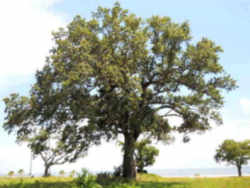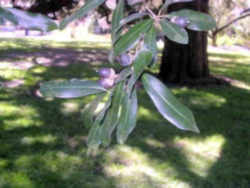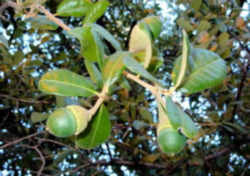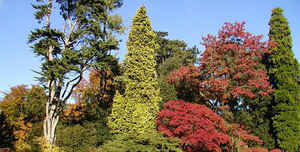
Georgia Symbols
Georgia State Tree
Live Oak

(Fagaceae Quercus virginiana)
Adopted on February 25, 1937.
On February 25, 1937, the live oak, (Fagaceae Quercus virginiana,) was adopted as the official tree of Georgia by . Joint Resolution No. 14, at the request of the Edmund Burke Chapter of the Daughters of the American Revolution, located in Waynesboro. Georgia selected the live-oak, as it is a tree indigenous to the soil of our State and especially flourishing along the Coastal plains and islands thereof where the first settlers and founders of this State resided, and which tree is so closely associated with our early history, and particularly with the lives of many famous Georgians such as General James Edward Oglethorpe, John Wesley and Sidney Lanier
Georgia State Tree: Live Oak

The Quercus virginiana is a species of oak found from Texas to Florida to Virginia. The common names for the Quercus virginiana include the Live Oak, the Southern Live Oak, and the Texas Live Oak. Size and growth varies depending on proximity to coastal regions. The larger Live Oaks tend to grow further inland, whereas Live Oaks in coastal regions tend to be smaller. Quercus virginiana produces small flowers during the spring, and the tree is pollenated by the wind. The Live Oak is also considered a rapidly growing species. The growth of the Live Oak begins very quickly, however as it becomes older its growth rate begins to decline.
It flourishes along the coastal plains and on the islands where the first settlers made their homes. Many famous Georgians, as early as General James Edward Oglethorpe, were able to enjoy its beauty.
Live oak (Quercus virginiana), also called Virginia live oak, is evergreen with a variety of forms, shrubby or dwarfed to large and spreading, depending upon the site. Usually live oak grows on sandy soils of low coastal areas, but it also grows in dry sandy Woods or moist rich woods. The wood is very heavy and strong but is little used at present. Birds and animals eat the acorns. Live oak is fast-growing and easily transplanted when young so is used widely as an ornamental. Variations in leaf sizes and acorn cup shapes distinguish two varieties from the typical, Texas live oak (Q. uirginiana var. fusiformis (Small) Sarg.) and sand live oak (Q. virginiana var. geminata (Small) Sarg.)
Common Names:
Live oak also called Virginia live oak.
Identification of the Live Oak

- Leaf: Alternate, simple, evergreen, leathery, 2 to 5 inches long, oblong or elliptical in shape with an entire or spiny and revolute margin. The upper surface is lustrous, the lower is pale and pubescent. Generally, not bristle-tipped.
- Flower: Staminate flowers borne on catkins. Pistillate flowers borne on spikes. Appearing March through May.
- Fruit: Acorns are in clusters of 3 to 5, maturing in one season. The nut is dark in color, 3/4 inch long and covered 1/3 by the cap. The cap is bowl-shaped and warty, termed "turbinate" by Harlow et al. Maturing in September of the first year.
- Twig: Slender, gray and pubescent, with small, blunt, multiple terminal buds.
- Bark: Rapidly developing red-brown furrows with small surface scales. Later, becoming black and very blocky.
- Form: A medium-sized tree that can grow to massive proportions. Open-grown trees develop a huge rounded crown. The largest crowns may be 150 feet across.
Joint Resolution of the Georgia General Assembly
Joint Resolution No. 14, read,
Joint Resolution of the Georgia General Assembly
Feb. 25, 1937
LIVE-OAK AS EMBLEMATIC TREE.
No. 14.
A Resolution.
Whereas in many of the States of the Union some tree indigenous to the soil of the State has been chosen as an emblem of its sovereignty; and
Whereas hitherto the General Assembly of Georgia has made no such selection; and
Whereas the live-oak, being a tree indigenous to the soil of our State and especially flourishing along the Coastal plains and islands thereof where
the first settlers and founders of this State resided, and which tree is so closely associated with our early history, and particularly with the lives
of many famous Georgians such as General James Edward Oglethorpe, John Wesley and Sidney Lanier;
Be it therefore resolved by the House of Representatives of Georgia, the Senate concurring, that, at the suggestion and request of Edmund Burke Chapter,
Daughters of the American Revolution, the live-oak be and the same is hereby adopted as and declared to be the official tree emblematic of the State
of Georgia.
Georgia Law
The law designating the live oak as the official Georgia state tree is found in the Georgia Code, Title 50, Chapter 3, Section 50-3-55.
Title 50. State Government.
CHAPTER 50-3.
SECTION 50-3-55.
50-3-55.
The live oak is adopted as the official tree emblematic of the State of Georgia.
Taxonomic Hierarchy: Live Oak
Kingdom: Plantae - Plants
Subkingdom: Tracheobionta - Vascular plants
Superdivision: Spermatophyta - Seed plants
Division: Magnoliophyta - Flowering plants
Class: Magnoliopsida - Dicotyledons
Subclass: Hamamelididae
Order: Fagales
Family: Fagaceae - Beech family
Genus: Quercus L. - oak
Species: Quercus virginiana Mill. - live oak







